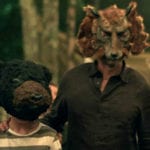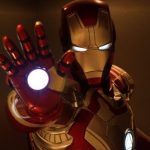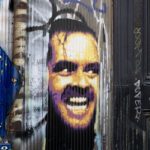 Music
Music  Music
Music  History
History 10 Less Than Jolly Events That Occurred on December 25
 Weird Stuff
Weird Stuff 10 Funny Ways That Researchers Overthink Christmas
 Politics
Politics 10 Political Scandals That Sent Crowds Into the Streets
 Weird Stuff
Weird Stuff Ten Bizarre Facts About The Doge Meme
 Our World
Our World 10 Ways Your Christmas Tree Is More Lit Than You Think
 Movies and TV
Movies and TV The 10 Coolest Stars to Set Sail on The Love Boat
 History
History 10 Things You Didn’t Know About the American National Anthem
 Technology
Technology Top 10 Everyday Tech Buzzwords That Hide a Darker Past
 Humans
Humans 10 Everyday Human Behaviors That Are Actually Survival Instincts
 Music
Music 10 Surprising Origin Stories of Your Favorite Holiday Songs
 History
History 10 Less Than Jolly Events That Occurred on December 25
 Weird Stuff
Weird Stuff 10 Funny Ways That Researchers Overthink Christmas
Who's Behind Listverse?

Jamie Frater
Head Editor
Jamie founded Listverse due to an insatiable desire to share fascinating, obscure, and bizarre facts. He has been a guest speaker on numerous national radio and television stations and is a five time published author.
More About Us Politics
Politics 10 Political Scandals That Sent Crowds Into the Streets
 Weird Stuff
Weird Stuff Ten Bizarre Facts About The Doge Meme
 Our World
Our World 10 Ways Your Christmas Tree Is More Lit Than You Think
 Movies and TV
Movies and TV The 10 Coolest Stars to Set Sail on The Love Boat
 History
History 10 Things You Didn’t Know About the American National Anthem
 Technology
Technology Top 10 Everyday Tech Buzzwords That Hide a Darker Past
 Humans
Humans 10 Everyday Human Behaviors That Are Actually Survival Instincts
Top Ten Worst Book to Movie Adaptations Ever Filmed
Millions of book lovers and moviegoers worldwide love seeing their favorite books and graphic novels come to life on the big screen. Roughly 70% of the top-grossing films in the last twenty years have been based on pre-existing literature. Sometimes, these adaptations are monumental successes like The Godfather. Despite having to cut out many parts of the original story in the name of time management, it can be magical when a film captures the essence of a great book.
On the other hand, when a movie fails to convey the proper message of a book onscreen, its audience can become hypercritical, with good reason. When one begins with a beloved piece of literature and takes it upon themselves to make a motion picture, they risk upsetting the existing fans. To save our readers from a less-than-perfect viewing experience, we’ve compiled a list of the worst movie adaptations of all time.
Related: 10 Lies ‘Dracula’ Adaptations Tell
10 The Scarlet Letter (1995)
The 1850 novel The Scarlet Letter by Nathaniel Hawthorne is an American classic studied in literature classes and revered by readers. It is a social and political commentary on adultery and hypocrisy. It is considered a masterpiece and is required reading for the enlightened. Unfortunately, the 1995 film adaptation hit its mark by such a distance that, despite its ensemble cast, it has become lost in obscurity.
Demi Moore plays Hester Prynne, a woman convicted of adultery; she’s convicted without revealing her unlawful partner’s identity. She receives jail time and public humiliation and is forced to wear a scarlet “A” on her person at all times. The movie makes significant changes to Hawthorne’s plot—including the ending—and loses the passion of the literary characters. It made less than a quarter of its production budget at the box office and received several satiric Golden Raspberry Awards.[1]
9 The Hobbit (2012–2014)
JRR Tolkien’s classic prelude to The Lord of the Rings is one of the most popular books of all time. Peter Jackson’s LOTR movie trilogy is an equally popular book-to-movie adaptation, having won many Oscars in the early 2000s. The Hobbit, while a good movie, had some mixed reviews. Despite the 558 minutes for the theatrical release and 686-minute extended cut, so much more could have gone into Jackson’s first trilogy without compromising the integrity of the books.
On the other hand, making three films out of the shorter stand-alone book did exactly that. Additional characters and subsequent plot lines were introduced to fill up three films worth of screen time. While all the LOTR movies could have been split into two, they were cut short, with additional scenes available on DVD and Blu-ray. The Hobbit would have made one good film, but as a trilogy, it leaves book fans wanting less.[2]
8 The Time Traveler’s Wife (2009)
Audrey Niffenegger’s 2003 novel The Time Traveler’s Wife has been widely renowned by book lovers worldwide. Classified as both science-fiction and romance, it has spawned a film and a TV series on HBOMAX. This film leaves much to be desired. The central plot remains the same in all three incarnations, but the approach varies in each.
A key difference noticed by fans is what triggers Henry’s time travel. In the book and the series, it’s happiness, whereas, in the movie, he’s triggered by trauma. The death of Henry’s mother plays a big part in his life, but the film opens up with his time traveling for the first time at the time of his mother’s death. There were a lot of seemingly small changes, such as Henry narrating the movie almost entirely, while chapters in the book alternate first-person views between him and Claire.
These minor changes compromised the story’s integrity so much that Niffenegger tweeted that she had never seen the movie adaptation but was extremely excited about the television show. The acting was mediocre, but more than that, this movie fails to capture the nuances of the main characters. Henry and Claire are atypical; they have alternative views on social constructs not present in this film, depriving their audience of the book’s full intent.[3]
7 Paper Towns (2015)
This John Green adaptation is a straightforward coming-of-age story that doesn’t do its protagonist justice. The characters lack darkness in the film, and so does the story as a whole. Quentin “Q” and Margot break into Sea World in the book. It is a pivotal sequence in the book filled with character development and danger that the movie cut out. The film makes many changes, but none so significant as the perception the others have of Margo. At no point during the movie does Q or anyone else consider the idea that Margo could have killed herself.
However, in the book, suicide is something they all think about, albeit ever so briefly. It creates a difference in tone between the book and the movie, the latter being less desirable. The film takes the dark seriousness out and leaves audiences with a cheerful road trip-type movie.[4]
6 The Bonfire of the Vanities (1990)
Warner Bros bought the movie rights for Tom Wolfe’s bestselling book The Bonfire of the Vanities for $750,000. The movie flopped despite an ensemble cast including Tom Hanks, Melanie Griffith, and Bruce Willis. Hanks and Griffith were not suitable for their roles, but director Brian De Palma’s first choices turned him down. The book had no likable protagonist, deliberately; it is a cynical examination of New York City and all its institutions.
While that concept worked for the novel, it didn’t translate well to the big screen. Knowing Hanks was anything but cynical, the producers decided to try to make the character ( Sherman McCoy) likable, completely changing the source material. The film’s only saving grace was the decision to let the shooting be recorded by Julie Salamon, allowing for The Devil’s Candy, the book based on the making of the film. The character McCoy is a Wall Street trader, and Salamon is a former Wall Street Journal film critic. Her novel was well received but, to date, has not been adapted to Fillmore television.[5]
5 The Girl on the Train (2016)
Paula Hawkins’s 2015 mystery thriller The Girl on the Train is an excellent example of modern psychological suspense fiction, but it made for a terrible film. Despite a spirited performance by Emily Blount, director Tate Taylor proved unable to handle a suspenseful thriller. The movie did well at the box office. The high number of sales contributed to fans of the novel, not to infer that they all went home happy.
The plot is good, filled with suspense and surprises, yet the film version still falls short. While there is only one significant change in the adaptation (the location has moved from London to New York), critics were just not compelled by Tate’s vision. Viewers felt that too many details were not explained, like the fact that Rachel was cheated on and that Anna was the other woman. The film may have been better as a trilogy and under a different director.[6]
4 The Green Hornet (2011)
The Green Hornet has, since 1936, survived in many mediums. Beginning on the radio and appearing in a 1940s film series, the Green Hornet has had countless adventures. In the 1960s, the hero continued as a TV series with Bruce Lee starring as Kato. This franchise has also produced comic books and graphic novels for nearly a century and is owned by Green Hornet Inc.
The 2011 film adaptation was abysmal. Fans of the comics ravaged the film online and blasted Seth Rogan’s portrayal of Britt Reid, aka the Green Hornet, calling him “useless.” This film is one of the recent trends of movie reboots. A popular Hollywood fad in the last twenty years is rebooting old action/drama TV series as cheesy comedies, and The Green Hornet, along with The Dukes of Hazzard and Starsky & Hutch, are prime examples. The Green Hornet is most famous for its long-running comic book series, and this film keeps nothing but the character names and basic premise. This campy, buddy-cop comedy with a side of action has not done this character any favors.[7]
3 Billy Bathgate (1991)
This 1989 E.L. Doctoral novel turned 1991 gangster flick was a box office flop. With Oscar-winning director Robert Benton and multi-Oscar-nominee Dustin Hoffman, there was no reason for this failure. Critics agree the missing ingredient was the protagonist’s narration which added to the book’s magic. Without it, the film seemed hollow and without focus.
Newcomer Loren Dean doesn’t do a lousy job with the titular character Billy, but it’s not enough to make up for the switch from first-person to third-person narration. Benton seems to go from making ordinary characters magical to portraying grandiose gangsters as mundane. Even the inspired performance of Dustin Hoffman as the legendary Dutch Schultz couldn’t spare this film from obscurity. With all the makings of a great mob movie, this adaptation was a huge letdown.[8]
2 Harry Potter and the Half-Blood Prince (2009)
J.K. Rowling’s Harry Potter book series has quickly become one of the most beloved and highest-grossing. The franchise produced eight movies from the seven books, splitting up only the final chapter into two films. Throughout the series, fans have pointed out plenty of omissions, but none so important as that in the sixth installment. The Half-Blood Prince book is the most important in fleshing out the antagonist, Voldemort. The sixth novel reveals his mother’s background and family history, which inevitably sets “The One Who Will Not Be Named” off on his pureblood crusade.
A significant section of the book depicts him slowly turning from Tom Riddle, a confused boy wizard, into Voldemort, the Dark Lord of Magic. This film relies heavily on the idea that its viewers have read the book. While that may often be the case, it doesn’t excuse skipping over one of the best parts of the Potter canon, making it the worst adaptation of the seven Harry Potter books.[9]
1 A Wrinkle in Time (2018)
Based on the 1962 sci-fi fantasy novel by Madeleine L’Engle, A Wrinkle in Time may be the worst book-to-movie adaptation of all time. This film brings together Oprah Winfrey, whose film performances have been limited over her 40-year career, and Oscar winner Reese Witherspoon. Winfrey and Witherspoon have had Oscar-caliber performances in the past, but they miss their mark in this film. As a result, the movie was a box office flop and lost millions.
Despite promoting diversity, the film was challenging to follow and overcompensated with CGI. This movie keeps to the book’s premise, but the details deviate in countless ways, from character background to the science to the climax. The ending varies just enough to disappoint. The film will most likely serve as a deterrent for Hollywood to adapt more classic fantasy novels into motion pictures, and that’s a shame.[10]








